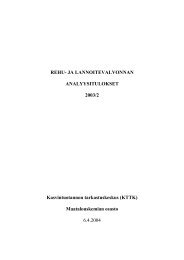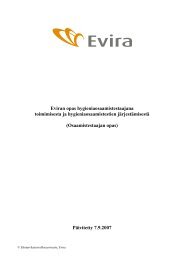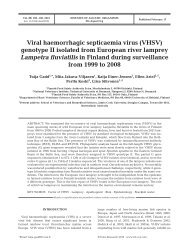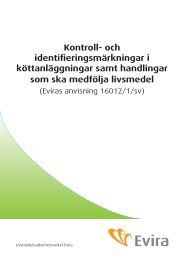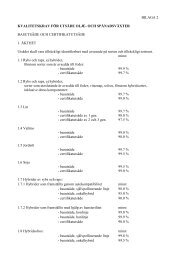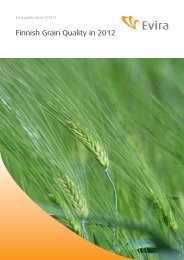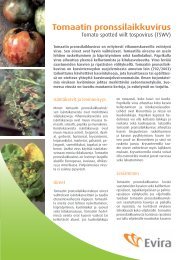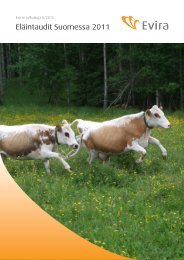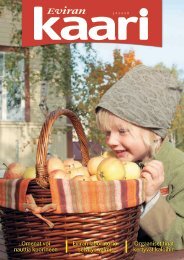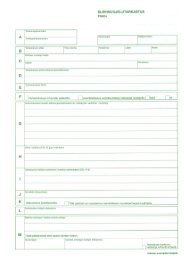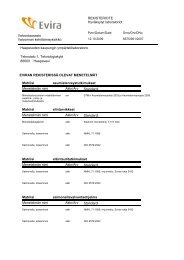Molecular characterization of endemic salmonella infections ... - Evira
Molecular characterization of endemic salmonella infections ... - Evira
Molecular characterization of endemic salmonella infections ... - Evira
You also want an ePaper? Increase the reach of your titles
YUMPU automatically turns print PDFs into web optimized ePapers that Google loves.
2.4 Risk assessment and risk management <strong>of</strong> <strong>salmonella</strong> <strong>infections</strong> in cattle<br />
Scientific risk assessments are important tools for estimating the magnitude <strong>of</strong> different risks and<br />
the effects <strong>of</strong> different interventions to control these risks (Maijala and Ranta 2003). The nature <strong>of</strong><br />
the risk, the possible consequences, and their probability are evaluated in the risk assessment<br />
process (National Veterinary and Food Research Institute 2005). It is based on four stages: hazard<br />
identification, hazard <strong>characterization</strong>, exposure assessment, and risk <strong>characterization</strong> (Ranta et al<br />
2004). The risk assessment begins with hazard identification, where the hazard (for example,<br />
<strong>salmonella</strong>) is identified on a general level. The hazard identification can address questions such<br />
as what kind <strong>of</strong> disease the Salmonella bacteria might cause, how the disease might spread, and<br />
what is the incidence and prevalence <strong>of</strong> <strong>salmonella</strong>. The hazard <strong>characterization</strong> includes a more<br />
detailed description <strong>of</strong> the hazard: the microbe itself, the symptoms it may cause, and how it<br />
affects its hosts. Exposure assessment is calculated based on basic information on the exposure<br />
to Salmonella. To be able to assess the risk <strong>of</strong> exposure, transmission models have to be made<br />
(Maijala and Ranta 2003; Ranta et al 2004). Different exposure models, such as the Bayesian<br />
Hierarchial Modeling (Ranta et al 2005), are used to assess the exposure or estimate the true<br />
<strong>salmonella</strong> prevalence. A general estimate <strong>of</strong> the risk <strong>of</strong> infection is produced by combining<br />
information derived from the exposure assessment with information about the dose-response. Risk<br />
<strong>characterization</strong> can be done once the risk <strong>of</strong> <strong>infections</strong> caused by Salmonella has been quantified<br />
using the exposure models (Maijala and Ranta 2003; Ranta et al 2004).<br />
When risk management actions are evaluated, the true prevalence or incidence should be the<br />
basis for evaluation. The Finnish Salmonella Control Programme (FSCP) was introduced in 1995,<br />
when Finland joined the EU. The aim <strong>of</strong> the programme was to keep the domestic <strong>salmonella</strong><br />
prevalence below 1 per cent along the food chain in broiler, turkey, beef, pork, and egg production.<br />
The FSCP for cattle is more like a monitoring system than a control programme. The regulations<br />
concerning cattle and beef production begin with feed control. All imported, marketed, and<br />
manufactured feed materials and compounded feeds are tested for Salmonella, and no batches<br />
with Salmonella detection are approved. The bulls for artificial insemination and their herds <strong>of</strong><br />
origin are required to test negative for Salmonella. Likewise all suspected cattle (with clinical<br />
symptoms or epidemiological evidence) are examined bacteriologically. The intention <strong>of</strong> this<br />
sampling and testing <strong>of</strong> cattle is to limit the spread <strong>of</strong> Salmonella between farms and animals<br />
(Tuominen et al 2007). If Salmonella is detected in cattle, the herd <strong>of</strong> origin is put under <strong>of</strong>ficial<br />
restrictions, including isolation <strong>of</strong> Salmonella-positive animals and the prohibition <strong>of</strong> animal<br />
movements. Faecal samples from all the animals are examined at one month intervals. The<br />
restrictions are lifted when two successive samplings are negative for Salmonella.<br />
21



